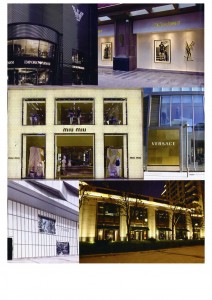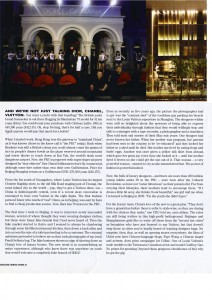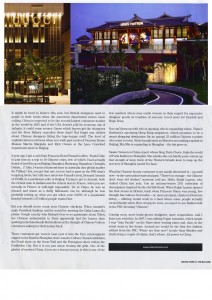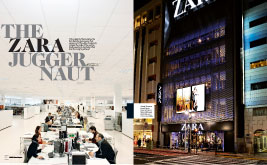Tag Archives: retail market
Holidaying with Ikea – AUSTRALIAN FINANCIAL REVIEW
That IKEA has caught on, to the tune of about $US23.5 billion in 2010, is in part directly due to my mother, who will always drive out of her way for napkins and a jar of herrings.
AFR | December 2011
by Marion Hume
I was really excited. I had travelled to the source – a bit like Burton and Speke and the source of the Nile, except for the details, such as Burton didn’t actually make it to Lake Victoria and I didn’t have a camel. No need for camels with such a massive parking lot. What lay before me was not nile green, but the world’s most recognized colour combination, yellow and blue. I had reached the birthplace of IKEA.
Actually, I’ve just lied a bit and I’m sad about that. Ingvar Kamprad opened the first IKEA in Smaland. But my Swedish friend insisted the Goteburg branch was better, so while I missed the thrill of the most ancient temple of flat-packing, a still historic source of self-assembly was good enough. I could barely contain my excitement as I grabbed my yellow ‘for use in store’ bag.
I should confess here that I love IKEA. I just do not understand why people hate it. I mean, even I can follow instructions and build a drawer. I also love that the designs are democratic, which is to say affordable and widely applicable. Not for you with your ‘shabby chic’ sitting room? But have you thought of how happily one of the $10 tables will sit next to your overstuffed armchair were you only to cover it in a pretty chintz cloth?
As for hiding in plain sight, one swanky decorator of my acquaintance stocks up on LACK bookshelves for oligarch clients’ homes. Sure, she puts the IKEA mostly in the chauffeurs and security guards’ accommodation, but she always sneaks a bit into the main house(s) because it fills the gaps. Then there’s the eco-thought, the sustainability, the effort that has gone in to flushing all those toilets with reclaimed grey water. I’m not crazy about the meatballs, but why linger in the canteen when there are wash bags to snap up, just like the ones at Prada but with more useful mesh pockets?
Still, I’ll concede that few people, when booking a holiday, want a Swedish farm house, by water, no internet access (on vacation from email) and an easy drive to IKEA. But then few can rival my connections to this mighty brand. Back in the 1950s, my parents, students at The Glasgow School of Art, both won travel scholarships to study Scandinavian design. Fueled by a shared love of skandichic, they returned to Sweden a second time just as an empire was dawning. I’ll say this for my canny Scots folks; while many others would have doubted anyone would pay to make their own furniture while there were craftsmen in every village, my Mum and Dad took one look at the LOVET table with removable legs (so it packed easily into the Volvo) and decided IKEA would could catch on. That it has, to the tune of about $US23.5 billion in 2010, is still, in part, directly due to my moth Perhaps it is because of this history that I am drawn to IKEA and indeed it
Perhaps it is because of this history that I am drawn to IKEA and indeed it is drawn to me. I once sat next to an IKEA kitchen designer on the plane to Shanghai; then I was on a little plane in Kenya and the woman next to me was part of an initiative to support women’s rights in communities. “Which NGO do you work for?” I asked. “IKEA,” she answered. But there’d be no need for an allen key in a manyatta mud hut.
Here’s what I observed in Gotenberg. In the kitchen sales area, there were people actually cooking. In the bed area, blondes of various sizes were testing a mattress via a family group hug. But most novel of all, people in workout gear were walking ‘the long natural way’ (the route designed to encourage the customer to see the store in its entirety) using those arctic ski poles. In an empire born in a cold country and on a bedrock of practical ideas, who could say they shouldn’t?
The Secrets of Zara’s Success – The Daily Telegraph
The Secrets of Zara’s Success
Classy, well-tailored, cheap-and ethical. Can the world’s favorite clothing store do no wrong?
by Marion Hume
The Daily Telegraph | June 22nd 20011
How do we love thee, Zara? Let us count the ways. Some numbers make a good place to start: a company founded on just €30 is now worth an estimated €32 Billion. Last week its parent company, Inditex, of which Zara represents over 60 percent, declared an 11 percent rise for the first quarter to €2.96 billion.
Translated, Zara was coining it while other retailers spent January to March moaning about recession and rising production costs. Next quarter’s financials look set to be more spectacular, if the response to the £49.95 blue dress worn by the Dutchess of Cambridge after her wedding is anything to go by.
So why do those as diverse as Kate and the business brains at Harvard which recently commissioned a study of the brand love Zara? Here’s a top 10.
1 The designs work in normal life.
Walk into a Zara. See anything you like? Thought so. A bug reason for this is that there is no Zara “style” – its appeal is broad. Yet you won’t find everyone else in the office in the same dress, and here lies the first clue to its supremacy. Although Zara may run up 30,000 copies of an item, supply is spread thinly over its 5,157 stores in 81 countries, plus its online shop. Scarcity plus realistic design equals kerching! at the cash till.
2 Fast Response to city-specific trends
A new white jacket arrived at the Manhattan flagship store. But customers passed, telling sales staff that New Yorkers prefer cream. A system is in place for retail staff to transmit such information straight to the design team at Arteixo, a tiny town in north-west Spain. Within a fortnight, a much bigger consignment of cream jackets had been dispatched to become a sell-out on 42nd street.
3 It’s mass with class
That Zara has its headquarters in Spain is significant. While influences are global, Spanish customers have always liked curvy cutting to flatter a proud bearing. The result is that Zara tailoring seems higher quality than other in this price range (blazers start at around £49.99), and styles are on-trend as opposed to too trendy.
4 A signifier of stylish city
A Zara store opening signifies a city has arrived sartorially. “Thank God, we won’t be a third-world fashion country any more,” said a Sydney- residing fan at the first Australian opening in April. Such was the delight down under that crowd control barriers had to be maintained for weeks. Those in Cape Town, Taipei and Lima may be equally excited.
5 Intrigue…
Just as consumers are driven by scarcity, so the press is intrigued by the greatest fashion story never told. Inditex founder Amancio Ortega, 75, the son of a railwayman who is now rated as the ninth richest man in the world, has never given an interview- and probably never will. Next month, he hands over to his equally taciturn second-in-command, Pablo Isla.
6 A Brilliant brand name
Those launching brands seek short, sharp names that work in every language. Yet this four-letter word was an accident. From 1963, Ortega’s company, which manufactured nightwear, was called Confecciones GOA (Amancio Ortega Gaona’s initials backwards). In 1975, he started to sell direct to public through a little shop in La Coruña and decided to call it Zorba. But the owner of a nearby bar of the same name protested. A new name had to come from the letter moulds already cast. Ironically, Spain is the only country in which Zara is pronounced not “Zah-rah” but “Tha-ra”.
7 The Green Frock
Inditex ups its eco rating by using wind turbines and solar power in its headquarters. Recaptured energy is even redirected into the steamers that press every garment. Items are despatched in battered boxes, which are reused and then recycled. Bicycles are provided for workers to whizz around inside vast warehouses. Green, yes- but is also makes good business sense because it saves money.
8 Seductive, sustainable store design
Store design is really working when you are too busy shopping to notice. Zara stores are built to seem airy and light-even on a busy Saturday-while the current in-store look, closely inspired by Prada, is for squadrons of mannequins gathered together to show off the season’s many looks. To decide on how its global stores should appear, Inditex tests entire “streetscapes” of prototypes for new-look Zara stores within a vast hanger at Arteixo. The radical Rome store, the prototype for all new builds, is on target to receive a platinum standard in Leadership in Energy and Environmental Design (LEED), a seal of sustainable architecture that is one of the most demanding of its kind.
9 A hooray from Harvard
The ultimate business plaudit is a study by Harvard business school. What do the money men love? That Zara turns the fashion system, which usually starts with the whim of a designer, on its head, by putting the customer at the heart of a unique business model. But there is a downside: for this model to thrive, Zara’s “designers” are strongly “inspired” by the creations of others, who are neither acknowledged nor paid. Not for nothing had Daniel Piette, fashion director of Louis Vuitton, described Zara as “the most innovative and devastating retailer in the world”.
10 Ethics Appeal
Inditex is intelligent in its generosity to charity. Following the Haiti earthquake, Inditex sent €2 million of emergency reconstruction relief as cash, not clothes. You might think that those who have lost everything need clothes, but as a result of other fashion giants sending these, local clothing industries have never recovered, leading to a greater dependency on aid, rather than trade.
In Spain, some stores’ employment practices make it possible for those with mental and physical disabilities to join the workforce.
But let’s hold back on awarding Zara that tenth love point for now; a somewhat murky supply chain makes all fast-fashion tough to love. Potentially vulnerable garment workers manning sewing machines in countries such as Bangladesh, Turkmenistan and Pakistan. In Zara’s favor, though, much of its production is in factories it owns in Spain, meaning it can guard against the scary labour practices that haunt the high street.
However, you can help by letting them know how much that matters and even that you are prepared to pay a little more and wait a little longer to ensure fashion is fairer.
Remember how they listen to customers asking for cream jackets? Use that system to ask for clean jackets at the cash till or via zara.com. You could also suggest that Zara provides “swing tags” that detail your garments journey to you.
Why would the world’s biggest fashion force care what you think? Because Inditex has conquered by putting the customer at the care of the story. Do speak up.
The Zara Juggernaut – Australian Financial review
The Zara Juggernaut
AFR Magazine | April 2o11
by Marion Hume
Spain’s remote corners are good at revolutions, from the gastrenomic one that began at a Catalonian country restaurant called El Bulli, to the fast-fashion phenomenon that sprang from the wilds of Galicia to conquer the malls of the world.
Given I have travelled across Europe to discuss a miracle, how fitting that the man I’ve come to meet is called Jesus. My pilgrimage has taken me to Spain’s North West, to Galicia, which is as far as you can go from the castanet cliche of the sun-backed south. For this is not the Costa del Sol, but the Costa del Muerte, the coast of death. At the very tip of the landmass, clinging like a barnacle to a rock and battered by sea spray, sits the little city of Coruna and just beyond it, along the rugged coast, Arteixo, a town of just 5,000 souls. Yet it is here that a global fashion phenomenon is headquartered.
If you track the markets, you may know of Inditex, which has experienced the kind of growth that makes you wish you could turn back time to the March 2001 IPO and scoop up some of the 40% equity floated on the Madrid Stock Exchange (60% remains with the founding family). Inditex, born in the late 1960s on an investment of just 30 euros (yes, E30, or 5,000 pesetas as it was in the old money) is now worth more than E 32 billion ($44 billion). So I’m looking forward to asking a man called Jesus Echevarria, the chief spokesman for the company, how that happened.
But first, I need to find him. The taxi arrives at a huge industrial estate. Sorry, what was that? Reception is across that courtyard, then down into the underground car park? When that turns out to be correct, the message is clear: no unannounced callers welcome here. Next, I take the lift up to reception, where a young woman in a headset greets me, then escorts me into a glass-sided lift. We rise up through blank, shiny floors that give no clue as to what happens here and then I wait alone in a boardroom, long enough to gaze out the window and realise that every 30 seconds, another huge truck pulls out from the loading bay down below and drives away.
“Hello! Sorry to keep you waiting. Coffee? I am Jesus,” says a man in a suit, bearing what is, in Spain, a relatively common name. He’s going to tell me more about a name that’s also pretty common, wherever you live in the world. If Inditex, which stands for Industria de Disena Textil might not mean much, have you ever heard of Zara? In the unlikely event you have not, brace yourself. The global fast fashion force is, at last, coming to Australia this month, a full decade after company scouts began arriving to study locations and logistics. The brand will open two stores, the first in Westfield Sydney with Melbourne to follow. “Thank God we won’t be a third world fashion country any more,” is how one Sydney fashion fanatic puts it.
Inditex is probably the biggest fashion company in the world; probably, because it depends on how you measure (there are mega retailers that sell lots of everything, including clothes, although this may not count as fashion). Inditex sells 700 million units per year globally. Within the empire, Zara is by far the most dominant brand (63.8%) and its sales for 2009 (the last full year available) were E7,077 millions. In 2005, Inditex overtook the Swedish fashion giant, Hennes & Mauritz (H&M); in 2008, it overtook the US one, Gap. Of the more than 5,000 stores Inditex has around the world about 1,700 of them are Zara boutiques. The parent company employs over 100,000 people belonging to more than 140 different nationalities.
The Zara name includes womenswear, menswear, children’s wear, homeware, accessories, perfume and now, zara.com. Yet the other Inditex brands are hardly tiddlers. These comprise Pull & Bear, Massimo Dutti, Bershka, Stradivarius, Oysho and Uterque, are names which don’t exactly trip off the tongue, but each does significant business around the world. Uterque for instance has some 80 stores in 16 countries. though heaven knows how people pronounce the names in any of them. In contrast, the name Zara works brilliantly because it is pronounced the same in every language bar one. (Ironically, that one is Spanish, where it is pronounced “Tha-ra”).
The choice of this convenient four letter word is however entirely accidental. Back in the ‘60s, the son of a railwayman called Amancio Ortega teamed up with his brother and his brother’s wife and started a business manufacturing shirts and nightwear (the best seller was a pink bathrobe for women). The wholesale business boomed and, in what would prove a turning point, Ortega realised that control, though at this time, not necessarily easy money- lay in owning stores in order to oversee the complete vertical process.
Had the company remained a manufacturer, it would doubtless be out of business today, as others have pulled production out of Spain in search of cheaper deals in Bulgaria, Romania and beyond. Instead, in 1975, Ortega opened a little shop in La Coruna – it is still there today – and decided to call it Zorba, as in Zorba the Greek. But the owner of a nearby bar of the same name saw the signage go up he protested. Ortega agreed to change it but, because you need costly moulds to make three dimensional store front lettering, he needed a name which could be made in the moulds already cast. So they repeated the “a” and Zara was born.
You are not about to meet Amancio Ortega, because the 75-year-old founder has never given an interview. Thus the 9th richest man in the world is far less known than those who sit above him on the Forbes rich list, such as the Mexican telecom titan, Carlos Slim Helu, Americans Bill Gates, Warren Buffet and Larry Ellison, the steel magnet Lakshmi Mittal and LVMH’s Bernard Arnault. Before the internet and camera phones, Amancio Ortega was never even knowingly photographed, but then a few pictures appeared online and now Inditex provides an official portrait. Apparently, there’s no mystery about why this twice married father of three doesn’t speak in public, he just doesn’t chose to. He didn’t even show for the Inditex IPO.
Although it has just been announced that he will move aside at the shareholders’ meeting in July 2011 and the current second-in-command, Pablo Isla Alverez de Tajera, will become both chairman and Chief Executive, Isla is unlikely to be much more available. “He does speak twice a year, at the AGM and the shareholders’ meeting. But no, we don’t expect him to do more,” says Echevarria, who remains the only company voice. So what is the secret of success? ““Maybe because we are on the edge, not at a crossroads,” he says. “We are here alone, which allows us to concentrate. But there’s more.”
A silent CEO is just one of the many ways in which one of the world’s most dynamic fashion forces is different. This is a story of going zig when others go zag. Beyond the obscure location on the edge of the Atlantic, and the odd fact that Zara spends almost nothing on advertising (most fashion brands factor in a minimum of 4% of turnover a year), nothing Zara actually does is done how others do it, to the point that the company became a subject of a Harvard Business School study which could be titled “Doing everything upside down.” (In fact it is called something so boring, such as “Inditex case study,” that I didn’t write it down).
Most fashion companies work like this; there are the designers. They design. There is a show. Meanwhile fabric is ordered for those designs, takes ages to arrive and then factories start to make the designs; the designs are advertised and the customer goes into the store to find them. At Zara, however, the customer goes into the store, sees a white jacket and says she’d prefer it in cream. If a couple more customers do that, two weeks’ later (perhaps less) there it is. The store is the centre piece and constant drops of new fashion to keep the customer coming back to see what’s new.
There is no Zara “style”, instead there a multiple styles, all of which disappear fast, so you won’t find everyone else wearing them. If a look doesn’t sell, it is pulled. There is , however, an innate Spanishness, which is to say, Spanish women, whether Castilian from Madrid or Catalunyan from Barcelona or Galician from Coruna, tend to have a proud bearing which they want flattered by tailoring; thus Zara’s jackets tend to be somewhat sexier, curvier of cut than others at these prices.
Because the vast geographical spread of the 5,000 Zara stores, a small production run is 30,000 pieces, leading to both economies of scale and the guarantee that hardly anyone you will ever bump into will have what you have. Stores order twice a week and the logistics that make that possible are astonishing (Think factory floors the size of way too many soccer pitches, full of clothing items flying around on tracks suspended from the ceiling and then ending up in specific cardboard boxes on which the store destination is already encoded. Those working in the warehouses move about by bicycle because the distances are so huge.)
As to why it has taken Zara so long to enter the Australian market, the company has been studying it for some time. “For Australia, we had to be convinced we could give our excellent service to a customer in the Southern Hemisphere,” Echevarria says. “We have 250 womenswear designers specifically thinking of the Northern Hemisphere and then the others of Argentina, Brazil, Chile, Uruguay, where of course we have shared heritage and language (as for Brazil, Galego, the regional language of Galicia, has similarities with Portuguese). We knew we couldn’t do last season’s clothes later for Australia, so we have been sending the design teams many times so they know what will work and at the right moment. It has taken us a long time to be ready because we are Zara and we know people expect us to get it right.”
Fashion folk love Zara, for its style and its speed. (From factory to store in 48 hours and the aim is to do that even for Australia). For those of us who like to poke our noses into company CSR (corporate social responsibility), Zara and parent company Inditex are popular too.
More than 50% of its offering, comprising most of its fast-fashion pieces, are made in factories it owns in Spain meaning it can guard against the kind of scary labour practices that haunt fast fashion. But as with all fast fashion (not specifically Inditex), once offshore, things are harder to police, this compounded by shoppers having come to expect low prices. Generally, campaigners and trade unions are alarmed at the cost of workers of a decade of deflation in clothing prices. But all Inditex’s 1,237 contracted suppliers are governed by the company’s External Manufacturers and Workshops Code of Conduct and it has also forged strong partnerships with international union bodies.
As to its eco friendliness, the message at HQ is demonstrated by a vast wind turbine soaring overhead. Being fortuitously positioned in a place that is both windy and sunny means much of the energy needs can be generated on the spot. In addition, Echevarria in intent on showing me how energy that would otherwise leech out and be lost has been redirected into the steamers that iron every garment. He is especially proud of the battered state of the cardboard boxes packed with goods for stores all over the world. These are reused and reused before being eventually recycled, he tells me.
Commendably Zara has gone far with its store design. Not only does every store turn its lights off for Earth Day, the latest opening, in Rome, aims to be the first ever fashion store to achieve the platinum standard certification, a seal of sustainable architecture that is one of the most demanding of its kind in the world. The company is working to make all stores eco efficient and older sites are being retrofitted. Echevarria is reluctant to let me take away a CSR report because it runs to 311 pages and this company hates to consume paper. Plastic bags are oxo biodegradable, meaning they break down to a small amount of biomass within two years, while traditional plastic bags take more than 400.
By studying the small print of the 22 pages concerning Inditex and society, I learn that the company has made emergency gifts in the multimillions in response to the earthquakes in Haiti and Sumatra, multiple gifts (of hundreds of thousands of Euro) to community and NGO projects in Cambodia, Morocco, Mali and beyond and that it builds some of its Spanish stores under its “for&from” project, which aims to make it possible for those with severe mental disabilities to join the workforce. So far, so good.
Where Zara does raise ire is when it comes to design, as in its appropriation of other people’s ideas. The model is only possible because both the design team and the customer is strongly inspired by the creation of others- who are neither acknowledged nor paid. While the likes of Topshop have overcome this criticism by supporting both London Fashion Week and British designers from deep pockets and H&M does high profile hi-lo collaborations with designers-most recently with Alber Elbaz of Lanvin- Zara does not.
Hussein Chalayan is just one originator who has seen the result of hours and hours of his labour hanging with a Zara label. Not that the fast fashion shopper, looking for something fabulous at a good price, cares a hoot. In the past, some designers actually used to be happy about Zara using their designs. Before the internet put every style on instant view, Inditex used to send teams around the world with a shopping spend that was legendary. I know of one French fashion label that used to factor in the Zara spend, not minding because Zara was mass and they were high end. Otherwise, designers have tended not to take on fast-fashion brands because altering a sleeve or changing a stripe tends to make clothing copyright cases notoriously difficult to prosecute. Not for nothing has Daniel Piette, then the fashion director of Louis Vuitton described Zara as *the most innovative and devastating retailer in the world”.
In February, Inditex brand Stradivarius was forced to U-turn after teenage style bloggers complained that images they had posted of themselves online had been reproduced rather too faithfully on the front of T-shirts. “It would have been no problem if they asked me,” one blogger told The Guardian. The article suggested that designers working in the vast studios at Inditex may be resorting to the internet to search out images of cool hipsters because of the pressure they are under to hit targets on the number of designs they produce each day. Zara alone is thought to produce some 40,000 designs a year.
While there’s a joke now that there’s a Zara opening somewhere every week, it was far from an overnight success. Ortega was 39 before he opened the first store, but after that it was as if he was making up for lost time. Stores opened at a heady pace, first in Spain, then Portugal. Location was always key – indeed the only Zara store not in a prime location is the first. The company launched itself in the US at a site bang opposite Bloomingdales on Lexington Avenue in 1989 and then on rue du Rivoli Paris in 1990.
The big question though- once Sydney and Melbourne are trading, once other sites across Australia are ear-marked for the Inditex brands as is also happening in South Africa- is where next. There are already more than 150 Inditex stores in China. Central and South America are conquered and the company has posted its flag all over South East Asia. But once New Zealand gets Zara (no plans yet revealed) where else is left? Especially as the global shopper can go to zara.com?
The answer may well be hidden away in a secret bunker in one of the vast buildings at Arteixo. Echevarria escorts me past extra security and then we walk into a vast empty space, with a heavy industrial curtain to the rear. He pulls it back enough for us to pass through and there is a whole Inditex street, of fully kitted out stores, none like you have seen before, including a whole new look for Zara women and Zara mens (think “more like Prada” and “more like Gucci” respectively).
But I suspect there is more. The night before my official meeting at Inditex, I have met up with an old friend who has connections deep inside the company. “There’s something completely new,” she tells me. So will the empire keep up the march, with another concept entirely. Tantalizingly, at the end of the secret Inditex street, there’s another curtain, but Echevarria steers me away. “We are thinking all the time of new concepts,” he says. But can’t he tell me more, given I have come all this, way? “We are always thinking,” he says, then adds “lunch?”. This being Spain, it’s past 3pm and I am, it has to be said, ravenously hungry. So Jesus and I head off for bread and fish and wine, Galician style. Whatever might be the next miracle, for now must stay a secret.








